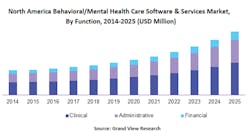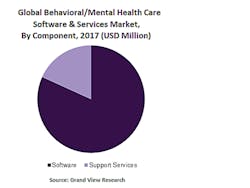What Factors Are Impacting the Mental Healthcare Software Market?
According to the survey “National Survey on Drug Use and Health” piloted by the Substance Abuse and Mental Health Services Administration (SAMHSA), substance abuse cost the U.S. approximately $600 billion per year. Behavioral healthcare providers help to control these costs by providing value-based medicine programs that prevent hospital readmissions.
Introducing IoT connected software, that can offer real-time patient monitoring and instant communication between patients and care providers, is one way to lower the growing cost of mental healthcare. Such improved technologies have the capability to overcome barriers such as confidentiality and information sharing, especially in cases specific to substance use and mental health information. It is crucial to integrate new technologies with other available treatment approaches to improve the productivity and effectiveness of the provided care.
Factors affecting the market growth are as follows:
- Rising awareness about substance abuse management
- Increased adoption of the technological solutions for the management of clinical, administrative, and financial functions
- Expanding reimbursement coverage in developed countries
Market Innovation Insights
Due to the nature of patients served in the market, a notable portion of the market will remain centered around community centers and non-profits. However, adoption of integrated care models and partnerships between local health systems are projected to provide impressive outcomes.
There is a high competition among industry players, as the behavioral health software market is driven by technologically advanced management solutions. For instance, in March 2017, Qualifacts Systems, Inc. introduced software solution for mobile behavioral health. The solution offers fully functional mobile apps for behavioral health staff.
In 2017, CMS introduced the behavioral health integration and psychiatric collaborative care model under the chronic care management services initiative. The reimbursements claimed through the above-mentioned programs favor primary care physicians. In January 2017, new behavioral health integration codes were introduced. These codes made it feasible to combine physical health treatment with behavioral health plans. The CMS announced the plans to develop an alternative payment model focusing on behavioral health services.
Cerner Corporation, Core solutions, Inc, EMIS Health, Epic, Meditab, Holmusk, Netsmart Technologies, Qualifacts Systems, Inc, and Welligent, Inc are some of the key players in the behavioral/mental health care software & services market.
Behavioral/Mental Health Care Software & Services Market Scenario
Grand View Research, a U.S.-based market research and consulting company, reported that the behavioral/mental health care software & services market is estimated to be worth USD $1.8 billion in 2017 and is expected to grow at a CAGR of 11.8% over the forecast period to reach a value of $4.3 billion.
According to the changes introduced by the Mental Health Parity and Addiction Equity Act of 2008 and the Affordable Care Act of 2010, mental health and substance abuse treatments have been established as essential healthcare benefits. In addition, the Medicaid and CHIP Managed Care Final Rule of 2016 increased available reimbursement coverage for patients and led to market growth. The growing reimbursement coverage in the developed countries such as the U.S., UK, and Germany have increased the interest of investors in the market.
Although around 74% of healthcare professionals have installed EHR systems in the U.S., only 29% have the ability to share data with other care providers and payers. Around 31% of primary care providers completely lack the ability to share data. In addition, less than 15% of the behavioral and mental healthcare organizations can actually share data in order to facilitate proper care coordination. This is due to low awareness regarding benefits of implementing behavioral health software solutions. Delivery of mental healthcare needs to shift toward patient-centric model rather than clinic-centric model.
North America behavioral/mental healthcare software & services market, by function, 2014-2025 (USD million) (Source: Grand View Research)
Segmentation of the Behavioral/Mental Health Care Software & Services Market
The behavioral/mental health care software & services market is segmented on the basis of component, delivery model, function, end use, and region.
Software dominated the component segment of behavioral health care market in 2017 and is also likely to witness the fastest CAGR at 12.3% over the forecast period. Consumers can directly access required services and information with help of mobile EHRs. Patients and care providers can connect with each other through secure and user-friendly portal. Claims and billing functionalities are integrated into EHR systems. Complex long-term billing procedures can be managed with the help of EHRs. Revenue cycle management is used to streamline the claims process.
Global behavioral/mental healthcare software & services market, by component, 2017 (USD million) (Source: Grand View Research)
Behavioral healthcare software solutions are available for purchase as well as for subscription. Subscription services held the majority of the market share in delivery model segment in 2017. The total share of subscription services is expected to increase by around 1.26% from 2017 to 2025. Moreover, subscription is likely to witness the fastest CAGR at 12.1% over the forecast period. On the other hand, ownership was the lesser-preferred delivery model in the market.
The clinical functions dominated the market in 2017 with a major revenue share. Large-scale mental health facilities have a wide pool of potential users. Hence, integration of clinical functions with their systems is required. Clinical functions are likely to retain the top position in the coming years, followed by administrative functions. The latter are expected to display the fastest growth rate over the forecast period at around 12.5%. Administrative functions consist of patient/client scheduling, document management, case management, workforce management, and business intelligence.
Document management is the fastest growing administrative function segment. Electronic documents need to have specific customizable templates, structured data, and outcome measures. Document management can eliminate the risk of data overload in hospitals, clinics, long-term care units, and rehabilitation centers.
Based on end use, the global behavioral/mental health care software & services market is segmented into providers (hospitals and clinics, community centers), payers, and patients. Providers dominated the end use segment in this market in 2017 in terms of revenue share at around 54%. They are likely to retain their top position throughout the forecast period. The rising behavioral health coverage and the government expenditure in behavioral health is likely to drive the adoption of management software solutions in the coming years in hospitals, as well as private practice clinics.
Payers are expected to experience the fastest growth rate at around 13% in the coming years due to the rise in reimbursement rates for mental health conditions. The reimbursement scenario in the U.S. for behavioral health software is promising. Medicare provides reimbursement for tele-mental health services. The covered costs include consultation charges, clinic visits, psychotherapy, pharmacology management, and interactive audio and video sessions. In the U.S., around 39 states have established guidelines related to telehealth reimbursement.
The regional segmentation includes North America, Europe, Asia-Pacific, Latin America, and Middle East and Africa. In 2016, North America dominated the overall market; publicly managed systems are present there for the management of mental health conditions and substance abuse. Availability of private as well as public insurance coverage has provided easier access to care in this region. In North America, the U.S. dominated the behavioral/mental health care software & services market with a market size of more than $700 million in 2017, growing at a CAGR of 11.2%.
Asia-Pacific is expected to witness lucrative growth with a CAGR of 11.6% during the forecast period. The rising geriatric population in Japan and China is expected to promote the emergence of the market in this region.
Pranita Bhor is a research analyst in medical devices and healthcare for Grand View Research.
About the Author
Pranita Bhor
Research Analyst
Pranita Bhor holds an MBA in biotechnology with specialization in marketing, with professional experience in the healthcare domain as well as market research. Presently, she is associated with the Medical Devices team at Grand View Research.



